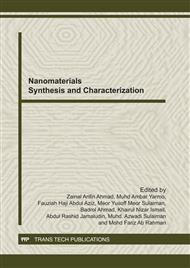p.408
p.412
p.417
p.422
p.427
p.434
p.439
p.444
p.450
Irradiation Modification of Epoxidized Natural Rubber/Ethylene Vinyl Acetate/Carbon Nanotubes Nanocomposites
Abstract:
The effect of irradiation on the mechanical properties of Epoxidized Natural Rubber/Ethylene Vinyl Acetate/Carbon Nanotubes (ENR/EVA/CNTs) nanocomposites were investigated. CNTs at various amount (2, 3, 4 and 6 wt%) were incorporated into ENR50 by solvent casting method. The ENR/CNTs were then blended with EVA by mixing in a Brabender Plasticoder at 120°C. Next, the samples were irradiated by using electron beam with 3 MeV electron beam machine in a dose range of 50 to 200 kGy. The mechanical properties such as tensile strength (Ts), modulus at 100% elongation (M100), elongation at break (Eb) and hardness of reinforced ENR/EVA/CNTs nanocomposites were studied as a function of radiation dose. It was found that, the Ts and M100 has increased almost 2 times compared to the nanocomposites without irradiation up to 150 kGy dose of radiation, and a downward trend thereafter. Gel fraction further confirmed the powerful energy of electron beam radiation result in irradiation-induced crosslinking and further enhanced mechanical properties of the nanocomposites.
Info:
Periodical:
Pages:
427-433
Citation:
Online since:
October 2011
Keywords:
Price:
Сopyright:
© 2012 Trans Tech Publications Ltd. All Rights Reserved
Share:
Citation:


